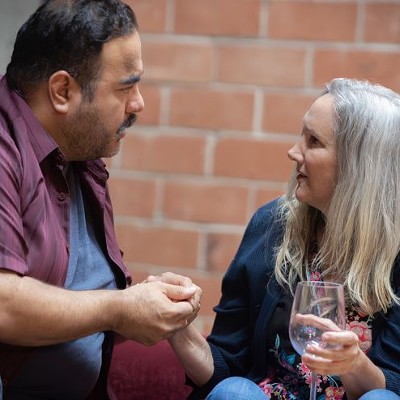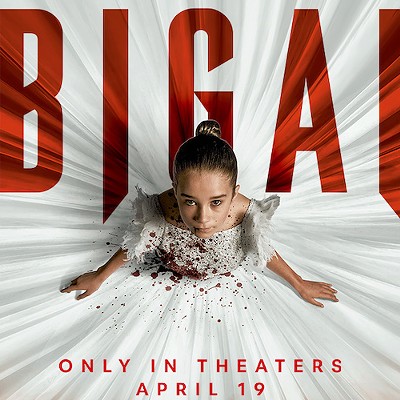Houston makes national news all the time. Sometimes it's our sports teams, sometimes it's the happenings over at NASA, a breakthrough at the Medical Center or our atrocious weather that's in the headlines. And sometimes it's Houston murders. Here are four Houston murders that made news and, in three cases, changed the justice system.
It was public pressure surrounding the 1977 murder Joe Campos Torres by Houston Police officers that prompted HPD to create an internal affairs division. Torres was 23 years old, and according to newspaper reports at the time, the Mexican-American Vietnam vet was known to have a drinking problem. In newspaper interviews, his family said he often became quarrelsome when he was drunk.
On May 5, 1977, Torres was arrested for a disturbance at an East End bar. Instead of taking him directly to jail, the six officers who responded to the call took Torres to “The Hole,” a spot along the banks of Buffalo Bayou near the 1200 block of Commerce, where they beat him. A lot.
They then took him to the city jail where he was deemed too injured for intake. Instead of transporting Torres to a hospital as they had been told to do, the six officers returned him to The Hole and beat him. Again.
At one point, HPD officer Terry W. Denson pushed Torres into the bayou, saying, ““Let’s see if the wetback can swim.” Apparently the drunk and injured Torres couldn’t. His body was found floating in the bayou two days later. It was Mother’s Day.
The Mexican-American community was outraged by the death and Torres’s family demanded justice.
That October, Denson and another officer, Stephen Orlando, were tried on murder charges and an all-white jury found them guilty of negligent homicide, a misdemeanor. Their sentence was one year probation and a $1 dollar fine.
Houston's Mexican-American community's outrage grew. Torres's family and community leaders organized protests against the decision, marching on HPD headquarters.
All six officers then faced federal charges for violating Torres’s civil rights. They were found guilty and given a ten year suspended sentence. Also found guilty of assault, Denson and Orlando were sentenced to nine months in prison.
The Hispanic community's outrage again grew. The family and community protested again. And again. But the case was settled and no further action was taken against the officers.
On the one year anniversary of Torres’s death, a riot broke out during a Cinco de Mayo celebration at Moody Park, on Houston’s north side. Police trying to arrest someone for fighting clashed with an angry crowd of Mexican-Americans. A rare citywide assist call went out for HPD. Officers, some wearing gas masks, tried to control the crowd but the violence and chaos spread into the neighborhood. Dozens of officers were injured; Jack Cato and Phil Archer, news reporters with KPRC Channel 2, were both stabbed repeatedly. By the end of the night, 14 cop cars had been burned, dozens of people were arrested and several nearby stores had been burned and looted.
Joe Campos Torres never got justice but HPD did get an internal affairs division.
The Hole remains visible today from a San Jacinto Street bridge that crosses Buffalo Bayou. The building currently at that site is part of the Harris County Sherrif's department. Hundreds of people walk across it every day as they make their way to the various criminal courts and Harris County jail, most unaware of The Hole or Joe Campos Torres.
The deaths of teenagers Jennifer Ertman and Elizabeth Pena shocked the country, both for the viciousness of the crime and the apparent lack of remorse among some of the perpetrators. The girls, 14 and 16 years old respectively, left a party around 11:15 p.m. on June 24, 1993. In order to make their 11:30 p.m. curfew, the two decided to take a shortcut along some railroad tracks and through T. C. Jester Park.
Five members of a local gang, Peter Cantu (18), Efrain Perez (17), Derrick Sean O'Brien (18), Joe Medellin (18) and his brother Venancio Medellin (14), were in the park initiating a new recruit, Raul Villarreal (17). They saw the girls walking past them and captured them. Over the next hour, the girls were repeatedly raped by all six attackers. They were sodomized and beaten before being strangled. The attackers then stomped on the girls' necks and kicked them until they were dead.
After the murders, Cantu and some of the other gang members went to his home where they bragged about the killing to family members. The badly decomposed bodies were found four days later when Cantu's older brother eventually tipped off police as to the location and the attackers.
During the various trials, the defendants showed little, if any, remorse.
The death of Jennifer Ertman and Elizabeth Pena led to a significant changes in victim's rights. Because of efforts by Ertman's father along with victims advocate Andy Kahan and others, victim's family members are now allowed to view the execution of a convicted killer.
The case affected criminal rights as well. Perez and Villarreal were under 18 at the time of the crime. Despite their ages, they were also given death sentences. That became a heated argument. The Supreme Court eventually decided the action was unconstitutional and the sentences were commuted to life. (Venancio Medellin, also a juvenile, had been given 40 years in prison.)
Joe Medellin was a Mexican citizen. He was given the death penalty but as he had not been allowed contact with the Mexican consulate at the time of his arrest, Mexico as well as several international justice advocates protested. (Mexico doesn't have the death penalty and blocks any death penalty sentences of its citizens by other countries.) Governor Rick Perry declined appeals from Mexico and a stay of execution from the World Court.
O'Brien and Medellín were executed in 2008. Cantu was executed in 2010.
The site of the Ertman - Pena murders remains a bank of White Oak Bayou. The railroad tracks there are still used daily by trains and occasionally by someone looking for a shortcut through the area. A few yards away from the site a memorial has been erected to the two girls. Twin benches, each bearing the name of one of the girls, sit under several oak trees. Plastic flowers, toys, dolls and other tokens of remembrance top both benches.
Clifford X. Phillips murdered Alley Theatre Managing and Artistic Director Iris Siff in the early hours of January 13, 1982.
The 47 year old Phillips, also known as Abdullah Bashir, had been a security guard with Security Guard Services, Inc. which provided the theater's security. He was fired for reportedly sleeping on the job. A few weeks later, he returned to the theater, entered through an unlocked door and made his way up to Siff's fourth floor office. He strangled Siff, who was 58 at the time, with a telephone cord and left taking her television, fur coat, bag and car.
The Houston Police Department first arrested Phillips's replacement, a Security Guard Services, Inc. employee named Robert Taylor. He was on duty at the time of the murder and HPD discovered he had served time in prison so he seemed a likely candidate. He was released after a few days.
Phillips was arrested in Los Angeles a few weeks later. He said he killed Siff in self-defense when she attacked him during the robbery.
Like Taylor, Phillips had a prison record. He had served time for killing his three-year-old son in 1970. (Philips forced water down the boy's throat and later stuffed his body into a suitcase.) Phillips had also been accused of beating his daughter into a vegetative state.
Despite their easily discovered criminal pasts, both men were hired by Security Guard Services, Inc.
Siff attended the Universidad Autónoma de México before receiving a bachelor's degree in theater from the University of Texas in 1944. She joined the Alley as an actress in 1948, just one year after the company's inception. She was a performer and costumer before she left the Alley to become a fashion coordinator and the director of special services at the Sakowitz department store.
She came back to the Alley in 1964 as founding director Nina Vance's assistant. Then in 1968 she became Managing Director for the theater and worked with architect Ulrich Franzen on the development of the Alley's current building. Vance died in 1980 and Siff became Managing and Artistic Director for the company.
Phillips was sentenced to death for Siff's murder. He was executed in 1993. In his final statement he said: "I want to express my feelings regarding the mishap of the deceased Mrs. Iris Siff. That was a very unfortunate incident and only God knows why it was an unintentional situation that took place."
Siff's family filed a wrongful death suit against Security Guard Services, Inc. and two of its employees; the case was settled out of court in 1984. One factor in the case was the criminal background of both Phillips and Taylor.
One month after Siff's death, Texas Monthly reporter Dick Reavis came to Houston to research the hiring and training practices of security firms in the city. He applied to 11 companies using his real name, age and place of birth along with various versions of a fabricated criminal past and work history. None of them discovered his lies, even though he took several lie detector tests as part of the application process. Six of the companies cleared Reavis for hiring. His article, Scarecrow Cops, detailed the security industry's failure to screen applicants.
Paul Broussard was a 27-year-old banker when he was attacked and killed in the Montrose area in 1991. Just after 2 a.m., Broussard and two friends were walking home after a night at a gay bar. Two vehicles drove up to the trio and one of the passengers asked for directions to a club. When the trio responded, nine teens and a 22-year-old, all from The Woodlands, exited the vehicles and attacked the men. His two friends managed to get away but Broussard was captured, beaten and stabbed.
Broussard lay injured at the site for hours. When EMS did arrive, he was able to talk and told them he wanted to be taken to St. Joseph Medical Center. Although he was badly beaten, had a broken rib and several puncture and stab wounds, the EMS staff decided his transportation was not an emergency but rather a low priority. They drove him to St. Joseph's with no lights or sirens, making what could have been an eight minute drive 40 minutes long instead. At the hospital, Broussard's treatment was further delayed and it was an hour before a doctor attended to him. He later died of internal injuries.
LGTB advocates cited homophobia and anti-gay sentiment as well as fear and misunderstanding of HIV/AIDS as factors in Broussard's medical treatment and the subsequent seemingly lackadaisical police investigation. (Queer advocate Ray Hill said the police had not even secured the site of the crime when he arrived on the scene hours later.)
The case was labeled a hate crime; the attackers admitted that they came to the heavily gay Montrose area to beat up a stranger. Gay advocates rallied and responded not only to the attack but to the delay in medical treatment Broussard received. Several large protests were organized, led by Broussard's mother, Nancy Rodriguez and LGBT advocates and politicos.
Jon Buice, the assailant who stabbed Broussard, turned himself in after prompting by family members. Eventually all of the attackers were arrested. The ten reached plea bargains and never went to trial. Five attackers received probation (two violated the terms of that probation and were sent to prison). Three others received 15-years-and-one-day prison sentences. One received 20 years (but was released after just six years) and Buice received 45 years.
Queer Nation and others deemed the sentences too lenient for the crime.
Broussard's mother was instrumental in keeping media attention and public pressure on the case through the sentencing phase and later parole hearings for each of the attackers. She was among the first family members to testify during the sentencing phase of an assailant in Texas. She successfully protested Buice's parole several times. Buice was released on parole in 2015 after serving 23 years. Ray Hill, who said he had a change of heart about Buice, was there to greet him.
Victims Advocate Andy Kahan was involved with the Paul Broussard case as well as that of Ertman-Pena. See our story HPD Investigating Victims' Crime Advocate Andy Kahan from Houston Press staff writer Craig Malisow on Kahan's alleged misconduct in the parole hearing of Broussard killer Jon Buice.
Earlier this year, Ernie Manouse produced a documentary film about the case, A Murder in Montrose: the Paul Broussard Legacy. In the film, Manouse contends that the Broussard case and the city's reaction to it led to the defeat of Mayor Kathryn Whitmire by Bob Lanier later that year. The case, among others, also led to hate crime legislation being passed in the state.
The site of Paul Broussard's death remains a parking lot for a small office building.
Support Us
Houston's independent source of
local news and culture
account
- Welcome,
Insider - Login
- My Account
- My Newsletters
- Contribute
- Contact Us
- Sign out
Murder Map Houston: The Locations of Infamous Local Murders
Olivia Flores Alvarez October 18, 2016 6:00AM
[
{
"name": "Related Stories / Support Us Combo",
"component": "11591218",
"insertPoint": "4",
"requiredCountToDisplay": "4"
},{
"name": "Air - Billboard - Inline Content",
"component": "11591214",
"insertPoint": "2/3",
"requiredCountToDisplay": "7"
},{
"name": "R1 - Beta - Mobile Only",
"component": "12287027",
"insertPoint": "8",
"requiredCountToDisplay": "8"
},{
"name": "Air - MediumRectangle - Inline Content - Mobile Display Size 2",
"component": "11591215",
"insertPoint": "12",
"requiredCountToDisplay": "12"
},{
"name": "Air - MediumRectangle - Inline Content - Mobile Display Size 2",
"component": "11591215",
"insertPoint": "4th",
"startingPoint": "16",
"requiredCountToDisplay": "12"
}
,{
"name": "RevContent - In Article",
"component": "12527128",
"insertPoint": "3/5",
"requiredCountToDisplay": "5"
}
]
KEEP THE HOUSTON PRESS FREE...
Since we started the Houston Press, it has been defined as the free, independent voice of Houston, and we'd like to keep it that way. With local media under siege, it's more important than ever for us to rally support behind funding our local journalism. You can help by participating in our "I Support" program, allowing us to keep offering readers access to our incisive coverage of local news, food and culture with no paywalls.
Olivia Flores Alvarez
Contact:
Olivia Flores Alvarez
Trending Arts & Culture
- Fallout Successfully Makes the Transition From Video Game to Streaming Show
- The 10 Best And Most Controversial Hustler Magazine Covers Ever (NSFW)
- Whose Story is It in The Father at 4th Wall Theatre Co.
-
Sponsored Content From: [%sponsoredBy%]
[%title%]

Don't Miss Out
SIGN UP for the latest
arts & culture
news, free stuff and more!
Become a member to support the independent voice of Houston
and help keep the future of the Houston Press FREE
Use of this website constitutes acceptance of our
terms of use,
our cookies policy, and our
privacy policy
The Houston Press may earn a portion of sales from products & services purchased through links on our site from our
affiliate partners.
©2024
Houston Press, LP. All rights reserved.




